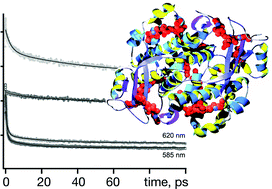Ultrafast light harvesting dynamics in the cryptophyte phycocyanin 645†
Abstract
Steady-state and femtosecond time-resolved optical methods have been used to study spectroscopic features and energy transfer dynamics in the soluble antenna

* Corresponding authors
a
Department of Chemistry, 80 St. George Street, Institute for Optical Sciences, and Centre for Quantum Information and Quantum Control, University of Toronto, Toronto, Ontario, Canada
E-mail:
gscholes@chem.utoronto.ca
Fax: +1 416 978 8775
Tel: +1 416 946 7532
b School of Physics, The University of New South Wales, Sydney, Australia
c Dipartimento di Chimica Generale ed Inorganica, Chimica Analitica e Chimica Fisica, Università di Parma, Parco Area delle Scienze, Parma, Italy
d Dipartimento di Chimica e Chimica Industriale, Università di Pisa, via Risorgimento 35, Pisa, Italy
e Centre for Immunology St. Vincent's Hospital, Sydney, Australia
Steady-state and femtosecond time-resolved optical methods have been used to study spectroscopic features and energy transfer dynamics in the soluble antenna

 Please wait while we load your content...
Something went wrong. Try again?
Please wait while we load your content...
Something went wrong. Try again?
T. Mirkovic, A. B. Doust, J. Kim, K. E. Wilk, C. Curutchet, B. Mennucci, R. Cammi, P. M. G. Curmi and G. D. Scholes, Photochem. Photobiol. Sci., 2007, 6, 964 DOI: 10.1039/B704962E
To request permission to reproduce material from this article, please go to the Copyright Clearance Center request page.
If you are an author contributing to an RSC publication, you do not need to request permission provided correct acknowledgement is given.
If you are the author of this article, you do not need to request permission to reproduce figures and diagrams provided correct acknowledgement is given. If you want to reproduce the whole article in a third-party publication (excluding your thesis/dissertation for which permission is not required) please go to the Copyright Clearance Center request page.
Read more about how to correctly acknowledge RSC content.
 Fetching data from CrossRef.
Fetching data from CrossRef.
This may take some time to load.
Loading related content
